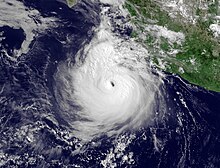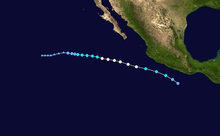Timeline of the 2011 Pacific hurricane season

The 2011 Pacific hurricane season officially started on May 15, 2011 in the eastern Pacific, designated as the area east of 140°W, and on June 1, 2011 in the central Pacific, which is between the International Date Line and 140°W, and will last until November 30, 2011. These dates typically limit the period of each year when most tropical cyclones form in the eastern Pacific basin. This timeline documents all the storm formations, strengthening, weakening, landfalls, extratropical transitions, as well as dissipation.
The first storm of the season, Hurricane Adrian formed off the southwest coast of Mexico. So far, seven tropical cyclones have developed during the season. All of these intensified into tropical storms, and six strengthened further into hurricanes.
Timeline graphic

Timeline of events
May
- No tropical cyclones formed during the month of May.
- May 15
June
- June 1
- 0700 UTC (12 a.m. PDT) – The 2011 Central Pacific hurricane season officially begins.
- June 7
- 1200 UTC (5 a.m. PDT) – Tropical Depression One-E, the first tropical depression of the season, forms from an area of low pressure south of Acapulco, Mexico.[2]
- June 8
- 0000 UTC (5 p.m. PDT June 7) – Tropical Depression One-E strengthens to Tropical Storm Adrian while meandering approximately 345 mi (555 km)* south of Acapulco, Mexico.[2]
- June 9
- 0000 UTC (5 p.m. PDT June 8) –Tropical Storm Adrian strengthens to Hurricane Adrian.[2]
- 1200 UTC (5 a.m. PDT) – Hurricane Adrian intensifies to a Category 2 hurricane.[2]
- 1800 UTC (11 a.m. PDT) – Hurricane Adrian rapidly intensifies to a Category 3 hurricane. [2]

- June 10
- 0000 UTC (5 p.m. PDT June 9) – Hurricane Adrian rapidly strengthens to a Category 4 hurricane. [2]
- 0600 UTC (11 p.m. PDT June 9) – Hurricane Adrian attains its peak intensity with winds of 140 mph (225 km/h) and a minimum barometric pressure of 944 mbar (hPa; 27.88 inHg).[2]
- 1800 UTC (11 a.m. PDT) – Hurricane Adrian weakens to a Category 3 hurricane.[2]
- June 11
- 0600 UTC (11 p.m. PDT June 10) – Hurricane Adrian rapidly weakens to a Category 1 hurricane.[2]
- 1800 UTC (11 a.m. PDT) – Hurricane Adrian rapidly weakens to a tropical storm.[2]
- June 12
- 1200 UTC (5 a.m. PDT) – Tropical Storm Adrian degenerates into a post-tropical remnant low while located roughly 570 mi (915 km)* southwest of Cabo San Lucas, Mexico.[2]
- June 19
- 1500 UTC (8 a.m. PDT) – Tropical Depression Two-E forms south of Mexico.[3]
- 1800 UTC (11 a.m. PDT) – Tropical Depression Two-E strengthens to Tropical Storm Beatriz.[4]
- June 21
- 0300 UTC (8 p.m. PDT June 20) – Tropical Storm Beatriz is strengthens to a Category 1 hurricane.[5]
- 1800 UTC (11 a.m. PDT) – Hurricane Beatriz weakens to a tropical storm.[6]
- June 22
- 0300 UTC (8 p.m. PDT June 21) – Tropical Storm Beatriz dissipates.[7]
July

- July 7
- 1500 UTC (8 a.m. PDT) – Tropical Depression Three-E forms south of Mexico.[8]
- July 8
- 0300 UTC (8 p.m. PDT July 7) – Tropical Depression Three-E strengthens to Tropical Storm Calvin.[9]
- 2100 UTC (2 p.m. PDT) – Tropical Storm Calvin strengthens to a Category 1 hurricane.[10]
- July 9
- 1500 UTC (8 a.m. PDT) – Hurricane Calvin weakens to a tropical storm.[11]
- July 10
- 0300 UTC (8 p.m. PDT July 9) – Tropical Storm Calvin degenerates into a remnant low.[12]
- July 17
- 1500 UTC (8 a.m. PDT) – Tropical Depression Four-E forms 265 miles (425 km) south-southwest of San Salvador.[13]
- 1800 UTC (11 a.m. PDT) - Tropical Depression Four-E strengthens to Tropical Storm Dora.[14]

- July 20
- 0300 UTC (8 p.m. PDT July 19) - Tropical Storm Dora strengthens to a Category 1 hurricane.[15]
- 1800 UTC (11 a.m. PDT) - Hurricane Dora strengthens to a Category 2 hurricane.[16]
- 2100 UTC (2 p.m. PDT) - Hurricane Dora strengthens into a Category 3 hurricane.[17]
- July 21
- 0000 UTC (5 p.m. PDT July 20) - Hurricane Dora strengthens to a Category 4 hurricane.[18]
- July 22
- 0300 UTC (8 p.m. PDT July 21) - Hurricane Dora weakens into a Category 3 hurricane.[19]
- 0900 UTC (2 a.m. PDT) - Hurricane Dora weakens into a Category 2 hurricane.[20]
- 1200 UTC (5 a.m. PDT) - Hurricane Dora weakens into a Category 1 hurricane.[21]
- July 23
- 0000 UTC (5 p.m. PDT July 22) - Hurricane Dora weakens into a Tropical Storm.[22]
- July 24
- 2100 UTC (2 p.m. PDT July 24) - Tropical Storm Dora degenerates into a remnant low.[23]

- July 31
- 0600 UTC (11 p.m. PDT July 30) – An area of disturbed weather 435 mi (700 km)* south of Acapulco is upgraded to Tropical Depression Five-E.[24]
- 1200 UTC (5 a.m. PDT) – Tropical Depression Five-E strengthens to Tropical Storm Eugene.[24]
August
- August 1
- 1800 UTC (11 a.m. PDT) – Tropical Storm Eugene strengthens to a Category 1 hurricane.[24]
- August 2
- 1800 UTC (11 a.m. PDT) – Hurricane Eugene intensifies to a Category 2 hurricane.[24]
- August 3
- 0600 UTC (11 p.m. PDT August 2) – Hurricane Eugene intensifies to a Category 3 major hurricane while located approximately 575 mi (925 km)* south-southwest of the southern tip of the Baja California Peninsula.[24]
- 1800 UTC (11 a.m. PDT) – Hurricane Eugene rapidly intensifies to a Category 4 hurricane.[24]
- 2100 UTC (2 p.m. PDT) – Hurricane Eugene attains its peak intensity with a barometric pressure of 942 mbar (hPa; 27.82 inHg) and winds of 140 mph (220 km/h).[24]
- August 4
- 0600 UTC (11 p.m. PDT August 3) – Hurricane Eugene rapidly weakens to a Category 3 hurricane.[24]
- 1800 UTC (11 a.m. PDT) – Hurricane Eugene rapidly weakens to a Category 2 hurricane.[24]

- August 5
- 0000 UTC (5 p.m. PDT August 4) – Hurricane Eugene rapidly weakens further to a Category 1 hurricane.[24]
- 1200 UTC (11 a.m. PDT) – Hurricane Eugene is downgraded to a tropical storm.[24]
- August 6
- 1200 UTC (11 a.m. PDT) – Tropical Storm Eugene degenerates into a post-tropical remnant low pressure area roughly 1,130 mi (1,820 km)* west of the southern tip of the Baja California peninsula.[24]
- August 15
- 2100 UTC (2 p.m PDT) - Tropical Depression Six-E formed about 1,630 mi (2,620 km) east-southeast of Ka Lae, Hawaii.[25]
- August 16
- 1500 UTC (8 a.m. PDT) - Tropical Depression Six-E strengthens into Tropical Storm Fernanda.[26]
- 2100 UTC (2 p.m. PDT) - Tropical Depression Seven-E formed 215 mi (346 km) south of Acapulco, Mexico.[27]
- August 17
- 0900 UTC (2 a.m. PDT) - Tropical Depression Seven-E strengthens into Tropical Storm Greg.[28]
- August 18
- 0300 UTC (8 p.m. PDT) - Tropical Storm Greg strengthens into a Category 1 hurricane.[29]

- August 19
- 1500 UTC (8 a.m. PDT) - Hurricane Greg weakens into a tropical storm.[30]
- August 20
- 2100 UTC (11 a.m. HST August 19) - Tropical Storm Fernanda weakens to a tropical depression.[31]
- 0300 UTC (5 p.m. HST August 19) - Tropical Depression Fernanda degenerates to a post-tropical cyclone.[32]
- August 21
- 0300 UTC (8 p.m. PDT August 20) - Tropical Storm Greg weakens to a tropical depression.[33]
- 1500 UTC (8 a.m. PDT) - Tropical Depression Greg degenerates into a remnant low.[34]
- August 31
- 1800 UTC (11 a.m. PDT) - Tropical Depression Eight forms.
September
- September 1
- 0300 UTC (8 p.m. PDT) - Tropical Depression Eight-E dissipates.
See also
References
- ^ Neal Dorst (January 21, 2010). "Subject: G1) When is hurricane season ?". National Hurricane Center. Retrieved 19 July 2011.
- ^ a b c d e f g h i j k Berg, Robbie. "Tropical Cyclone Report: Hurricane Adrian" (PDF). National Hurricane Center. Retrieved 10 September 2011.
- ^ Michael Brennan (June 19, 2011). "Tropical Depression Two-E Advisory Number 1". National Hurricane Center. Retrieved 19 July 2011.
- ^ Michael Brennan (June 19, 2011). "Tropical Storm Beatriz Advisory Number 2". National Hurricane Center. Retrieved 19 July 2011.
- ^ Richard Pasch and Chris Landsea (June 21, 2011). "Hurricane Beatriz Advisory Number 7". National Hurricane Center. Retrieved 19 July 2011.
- ^ Michael Brennan (June 21, 2011). "Tropical Storm Beatriz Intermediate Advisory Number 9-A". National Hurricane Center. Retrieved 19 July 2011.
- ^ Richard Pasch (June 22, 2011). "Tropical Depression Beatriz Advisory Number 11". National Hurricane Center. Retrieved 19 July 2011.
- ^ Lixion Avila (July 7, 2011). "Tropical Depression Three-E Advisory Number 1". National Hurricane Center. Retrieved 19 July 2011.
- ^ Stacy Stewart (July 8, 2011). "Tropical Storm Calvin Advisory Number 3". National Hurricane Center. Retrieved 19 July 2011.
- ^ Lixion Avila (July 8, 2011). "Hurricane Calvin Advisory Number 6". National Hurricane Center. Retrieved 19 July 2011.
- ^ Stacy Stewart (July 9, 2011). "Tropical Storm Calvin Advisory Number 9". National Hurricane Center. Retrieved 19 July 2011.
- ^ Stacy Stewart (July 10, 2011). "Tropical Depression Calvin Advisory Number 11". National Hurricane Center. Retrieved 19 July 2011.
- ^ Stacy Stewart (July 17, 2011). "Tropical Depression Four-E Advisory Number 1". National Hurricane Center. Retrieved 19 July 2011.
- ^ Stacy Stewart (July 18, 2011). "Tropical Storm Dora Tropical Cyclone Update". National Hurricane Center. Retrieved 19 July 2011.
- ^ Daniel Brown (July 20, 2011). "Hurricane Dora Advisory Number 7". National Hurricane Center. Retrieved 20 July 2011.
- ^ Eric Blake and Jack Beven (July 20, 2011). "Hurricane Dora Intermediate Advisory Number 9-A". National Hurricane Center. Retrieved 20 July 2011.
- ^ Eric Blake and Daniel Brown (July 20, 2011). "Hurricane Dora Advisory Number 10". National Hurricane Center. Retrieved 20 July 2011.
- ^ Daniel Brown (July 21, 2011). "Hurricane Dora Intermediate Advisory Number 10-A". National Hurricane Center. Retrieved 21 July 2011.
- ^ Richard Pasch (July 22, 2011). "Hurricane Dora Advisory Number 15". National Hurricane Center. Retrieved 22 July 2011.
- ^ Chris Landsea and Stacy Stewart (July 22, 2011). "Hurricane Dora Advisory Number 16". National Hurricane Center. Retrieved 22 July 2011.
- ^ Eric Blake and Jack Beven (July 22, 2011). "Hurricane Dora Advisory Number 17". National Hurricane Center. Retrieved 22 July 2011.
- ^ James Franklin (July 23, 2011). "Hurricane Dora Intermediate Advisory Number 18-A". National Hurricane Center. Retrieved 23 July 2011.
- ^ Richard Pasch (July 24, 2011). "Post-Tropical Cyclone Dora Advisory Number 26". National Hurricane Center. Retrieved 26 July 2011.
- ^ a b c d e f g h i j k l Blake, Eric. "Tropical Cyclone Report: Hurricane Eugene" (PDF). National Hurricane Center. Retrieved 20 September 2011.
- ^ Robbie Berg (August 15, 2011). "Tropical Depression Six-E Advisory Number 1". National Hurricane Center. Retrieved 16 August 2011.
- ^ Eric Blake (August 16, 2011). "Tropical Storm Fernanda Advisory Number 4". National Hurricane Center. Retrieved 16 August 2011.
- ^ Robbie Berg (August 16, 2011). "Tropical Depression Seven-E Advisory Number 1". National Hurricane Center. Retrieved 16 August 2011.
- ^ John Cangialosi (August 17, 2011). "Tropical Storm Greg Advisory Number 3". National Hurricane Center. Retrieved 17 August 2011.
- ^ Daniel Brown (August 18, 2011). "Hurricane Greg Advisory Number 6". National Hurricane Center. Retrieved 18 August 2011.
- ^ Stewart and Wroe. "Tropical Storm Greg Advisory Number 12". National Hurricane Center. Retrieved 19 August 2011.
- ^ Kevin Kodama. "Tropical Depression Fernanda Advisory Number 17". Central Pacific Hurricane Center. Retrieved 21 August 2011.
- ^ Kevin Kodama. "Post-Tropical Cyclone Fernanda Advisory Number 18". Central Pacific Hurricane Center. Retrieved 21 August 2011.
- ^ Brennan and Wroe. "Tropical Depression Greg Advisory Number 18". National Hurricane Center. Retrieved 21 August 2011.
- ^ Kimberlain and Wroe. "Post-Tropical Cyclone Greg Advisory Number 20". National Hurricane Center. Retrieved 21 August 2011.
External links
Tropical cyclones of the 2011 Pacific hurricane season | ||
|---|---|---|

